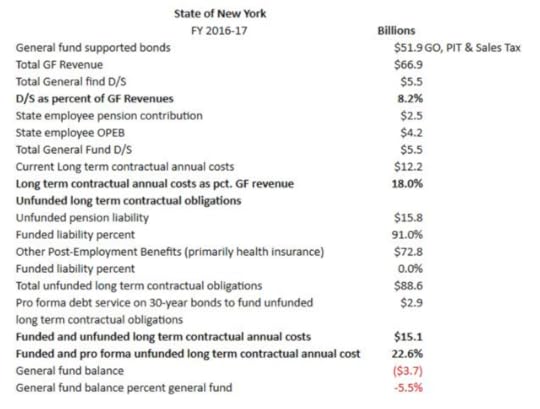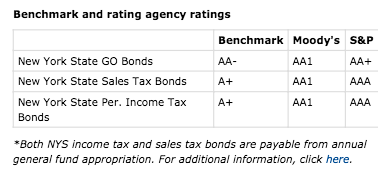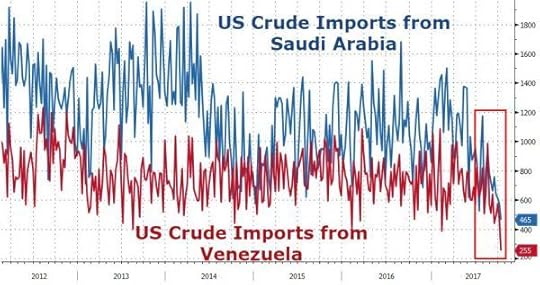Steve Bull's Blog, page 1282
October 18, 2017
Ray Dalio’s Shorting The Entire EU

Salvator Rosa Heroic battle 1652A point BOE Governor Mark Carney made recently may be the biggest cog in the European Union’s wheel (or is it second biggest? Read on). That is, derivatives clearing. It’s one of the few areas where Brussels stands to lose much more than London, but it’s a big one. And Carney puts a giant question mark behind the EU’s preparedness.
Carney Reveals Europe’s Potential Achilles Heel in Brexit Talks
Carney explained why Europe’s financial sector is more at risk than the UK from a “hard” or “no-deal” Brexit. [..] When asked does the European Council “get it” in terms of potential shocks to financial stability, Carney diplomatically commented that “a learning process is underway.” Having sounded alarm bells about clearing in his last Mansion House speech, he noted “These costs of fragmenting clearing, particularly clearing of interest rate swaps, would be born principally by the European real economy and they are considerable.”
Calling into question the continuity of tens of thousands of derivative contracts , he stated that it was “pretty clear they will no longer be valid”, that this “could only be solved by both sides” and has been “underappreciated” by Europe . Carney had a snipe at Europe for its lack of preparation “We are prepared as we should be for the possibility of a hard exit without any transition…there has been much less of that done in the European Union.”
In Carneys view “It’s in the interest of the EU 27 to have a transition agreement. Also, in my judgement given the scale of the issues as they affect the EU 27, that there will ultimately be a transition agreement. There is a very limited amount of time between now and the end of March 2019 to transition large, complex institutions and activities…
…click on the above link to read the rest of the article…
LAPD Gets Approval To Unleash Drone Program As Protesters Take To The Streets
The LAPD first toyed with the idea of ramping up its public spying safety program with the introduction of drones back in May 2014. At that time, the LAPD announced it had acquired two “unmanned aerial vehicles” as gifts from the Seattle Police Department, Draganflyer X6 aircraft to be exact, after a public outcry in Seattle grounded the controversial program. Unfortunately, or perhaps not, LA’s drone efforts quickly met the same fate as Seattle’s after a public outcry.
But, ‘if at first you don’t succeed, try, try again’ seems to be the motto for the LAPD which, after 3 years of patiently waiting, finally received approval from a civilian oversight committee to unleash its drone program on the general public. Per the LA Times:
After months of often-heated debate, a civilian oversight panel Tuesday signed off on a yearlong test of drones by the Los Angeles Police Department, which will become the largest police department in the nation to deploy the controversial technology.
The Police Commission’s 3-1 vote prompted jeers, cursing and a small protest that spilled into a downtown intersection just outside the LAPD’s glass headquarters — evidence of the opposition police have faced in recent weeks as they tried to reassure wary residents that the airborne devices would not be misused.
The use of drones — or “small Unmanned Aerial Systems,” in police-speak — has become a contentious issue for law enforcement in Los Angeles, where the nation’s largest sheriff’s department has flown one since January.
LAPD brass, along with police commissioners, tried to ease those concerns by promising careful restrictions on when the drones would be used and strong oversight of the pilot program. Weapons and facial-recognition technology will also be prohibited.

…click on the above link to read the rest of the article…
Creditworthiness of New York and Illinois: One is Bankrupt
Summary
Unless used for capital improvements, any new Illinois State borrowing, regardless of security structure, will amount to nothing more than kicking the can further down the road.
Markets remain open to uncreditworthy government borrows longer than they should. In a low interest rate environment, investors will stretch credit standards.
Benchmark bond ratings are at variance with the rating agencies.
Everyone knows Illinois’ financial condition is poor. Conventional thinking seems to be that a bond default, should that happen, would be many years in the future. Pardon me, but wasn’t that the thinking right up to Puerto Rico’s, “We can’t pay” announcement? To answer the question of just how badly off is Illinois, I assembled a list of key creditworthiness indicators and applied them to New York, a highly rated state, and Illinois.
COMMENTARY AND BENCHMARK PRIVATE BOND RATINGS
The State of New York is managing its financial resources and obligations in a better-than-average manner. Particularly, the State’s employee pensions are reported to be 90% funded, but the general fund deficit must be contained and then eliminated. Unfunded OPEB costs are too high and can be renegotiated. Funded and pro forma unfunded long-term contractual obligations equaled 23% of general fund revenue in FY ended June 30, 2017, and exceeds the 15% threshold for a Benchmark AA or AA+ credit rating.
*Both NYS income tax and sales tax bonds are payable from annual general fund appropriation. For additional information, click here .
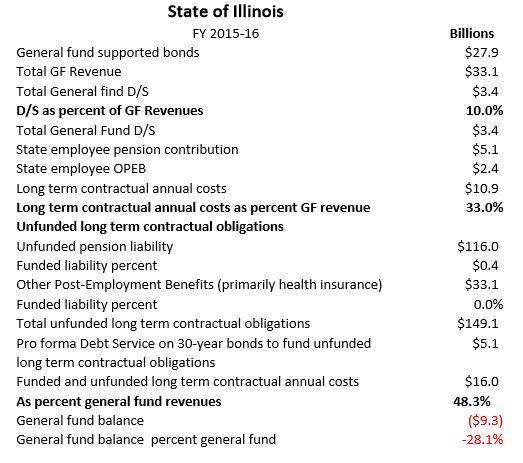
COMMENTARY AND BENCHMARK PRIVATE BOND RATINGS
The State of Illinois, in my opinion, is past the point of no return. It does not have the ability to raise taxes or cut spending to the degree necessary to reduce the annual cost of bond and retiree benefits from 33% to a sustainable level. The amount of debt issued by Illinois requires a moderate 8% of general fund revenues to pay P&I.
…click on the above link to read the rest of the article…
Oil Algos Shocked As US Crude Production Crashes Most In Over 5 Years
Following API’s huge 7.1mm barrel crude draw overnight, WTI prices are slightly higher (driven more by OPEC jawboning) as last week’s API errors are still on traders’ minds, but DOE confirmed a big crude draw but notable builds in gasoline and distillates surprised. However, the biggest headline is likely the 11%-plus collapse in US crude production…
API
Crude -7.13mm (-3.2mm exp) – biggest draw in 2 months
Cushing -151k – first draw in 2 months
Gasoline +1.951mm (+1.05mm exp)
Distillates +1.644mm – biggest in 3 months
DOE
Crude -5.73mm (-3.2mm exp)
Cushing +202k
Gasoline +908k (+1.05mm exp)
Distillates +528k (-1.5mm exp)
Traders clearly did not trust the API data (after last week’s flip-flop) but DOE confirmed a big draw and notable builds in both gasoline and distillates…
As a reminder – Supplies remain bloated at about 21% above the five year average despite rising exports.
US Crude imports from Venezuela and Saudi Arabia have collapsed to record lows…
Following the previous week’s drop in production, this week saw a 12% collapse in US Lower 48 output – presumably affected by Hurricane Nate!!

The biggest drop since Hurricane Isaac in Aug 2012
Energy complex prices had limped higher into the DOE print – with even OPEC jawbining unable to really budge them… and the oil agos are completely bewildered now after the collapse in production…
If a North Korean EMP Could Kill 90% of Americans in a Year, Why Did the DoD Just Defund the Congressional EMP Commission?
At a House hearing yesterday, experts warned members of Congress that a North Korean EMP attack could kill 90% of Americans within one year, calling it an “existential threat.” But despite this looming crisis, the Department of Defense has decided now was the time to defund the Congressional committee that has been studying the threat since 2001.
The Commission to Assess the Threat to the United States from Electromagnetic Pulse (EMP) Attack has been around for nearly two decades, but their efforts have mostly been restricted to making sure that the U.S. national command authority and U.S. strategic forces could continue to function. Meanwhile “no major efforts were then thought necessary to protect critical national infrastructures.” Apparently, the plan was that our defense would be so effective, no further steps were needed.
This has all changed with recent strides in nuclear weaponry by North Korea. The results of an EMP strike could be apocalyptic.
With the development of small nuclear arsenals and long-range missiles by new, radical U.S. adversaries, beginning with North Korea, the threat of a nuclear EMP attack against the U.S. becomes one of the few ways that such a country could inflict devastating damage to the United States. It is critical, therefore, that the U.S. national leadership address the EMP threat as a critical and existential issue, and give a high priority to assuring the leadership is engaged and the necessary steps are taken to protect the country from EMP. (source)
What a lot of people didn’t know was that just a couple of weeks ago, Sept. 30, 2017, the Department of Defense terminated the funding for the EMP Commission.
…click on the above link to read the rest of the article…
Has the American Hegemon Gone Rogue?

Has the American Hegemon Gone Rogue?
During the US electoral campaign last year people of various political convictions feared that the election of Hillary Clinton as US president might lead to a military confrontation with the Russian Federation. On the other hand, Donald Trump declared that better relations with Russia appeared to him to be in US interests. That’s the way it seemed during the electoral campaign. But you know, in the west, candidates will say a lot of things to get elected before settling into the business as usual of their predecessors. The Deep State does not allow transient politicians to make big changes which harm its interests. So Trump came into power making promises to try to improve US-Russian relations only to pursue the “same ol’, same on” policies of his predecessor, Barack Obama.

Mr. Trump did eventually meet with President Vladimir Putin for lengthy talks at the G20 summit in Germany during the summer, and the feedback afterward was positive
This was what Obama intended for he did as much as he could to tie Trump’s hands, expelling, gratuitously it appears in December 2016, Russian diplomats and confiscating Russian diplomatic properties. President Trump said he was going to “clean out the swamp” in Washington, and instead “the swamp” sucked him in up to the ears. As might have been expected, neocons quickly highjacked his presidency. Virtually the entire team he brought into the White House with him is already gone. The first to be targeted was retired General Michael Flynn who lasted only a few weeks. He was forced to resign because of allegations that he had conducted inappropriate discussions with the Russian ambassador in Washington. Mr. Trump did eventually meet with President Vladimir Putin for lengthy talks at the G20 summit in Germany during the summer, and the feedback afterward was positive. But once Trump returned to Washington, he was quickly brought back into line. He had to sign a Congressional bill imposing even moresanctions on Russia.
…click on the above link to read the rest of the article…
You cannot have a war economy if there is no war. My 4th presentation of “The Seneca Effect” in Paris

Above, at the Momentum Institute in Paris on Friday 13th, 2017. Ugo Bardi is on the left of the photo, Yves Cochet (president of the institute) is at the center, with the white shirt.
The presentation at the Institut Momentum on Oct 13th was the fourth of a series of presentation related to my book “The Seneca Effect” that I gave in Paris last week. This one was probably the least formal one of the series. I gave some explanation of how system dynamics models can produce the asymmetric “Seneca Curve,” but I concentrated on a section of the book, the one dealing with the extermination of whales during the 19th century. It is a theme related to the concept of Anthropocene: the human relation with the ecosystem.
The point that I try to stress in these presentations is that most people, including decision-makers, just don’t have the concept of “overshoot”, that is the tendency of consuming more resources than the system can produce, forcing it to crash down after some time. It is something that I described also in a previous talk.
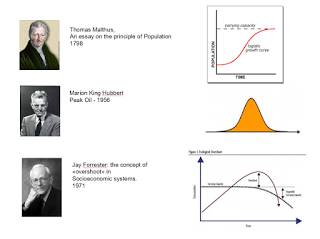
The problem, here, is that not having the concept of overshoot, people happy go along the Seneca trajectory, thinking that the more resources they can extract from the system, the better things are for them. They don’t realize that the more they go up, the faster they’ll have to crash down. I surmised that we have a cultural problem: it is a relatively new concept that will have to penetrate culture. That will take time and it is not obvious that it will ever happen.
…click on the above link to read the rest of the article…
Lessons from the front lines of anti-colonial pipeline resistance

A bridge leads to the entrance of the Unist’ot’en territory in British Columbia, Canada. (WNV/Jeff Nicholls)
The Standing Rock standoff over the Dakota Access Pipeline was a reminder that colonization, and resistance to it, both exist in the present tense. Fossil fuel pipelines that despoil indigenous lands and waters have become key flashpoints in long-standing anti-colonial resistance.
An important precursor and inspiration for the Standing Rock camp is an indigenous occupation in northern British Columbia, Canada. For the past eight years, the Unist’ot’en clan have reoccupied their traditional territory. When the camp began in 2009, seven pipelines had been proposed to cross their territory, as well as their water source, the salmon-bearing Morice River. But thanks to Unist’ot’en resistance, oil and gas companies have been blocked from building new fossil fuel infrastructure. The lesser known but wildly successful Unist’ot’en encampment holds crucial lessons for anti-pipeline and anti-colonial organizers across North America, or Turtle Island, as many indigenous nations call it.
We visited the occupation this summer. Upon arriving, visitors must undergo a border-crossing protocol. There is only one way in and out of Unist’ot’en territory – a bridge that crosses the Morice River. Before being allowed to cross, we were asked where we came from, whether we worked for the government or the fossil fuel industry, and how our visit could benefit the Unist’ot’en.
We explained that we are both settlers, people living on and benefiting from indigenous lands. We also expressed our willingness to help in whatever ways were needed during our stay, such as kitchen duty, gardening and construction. Finally, we shared our commitment to decolonization and climate justice, and our appreciation for how Unist’ot’en land defense accomplishes both; it returns indigenous lands to indigenous peoples while blocking fossil fuel infrastructure that threatens the entire human estate. After a short consultation, clan members welcomed us to leave Canada and cross into Unist’ot’en territory.
…click on the above link to read the rest of the article…
Half A Million Bpd At Risk From Geopolitical Firestorm
[image error]
It’s been a long time since geopolitical developments caused major movements in the oil price, but the escalating tension between the U.S. and Iran, combined with the sudden military clashes in Iraq, has pushed geopolitical risk back on to the agenda for the oil market.
“Geopolitical risks to the oil market have continued to intensify,” Goldman Sachs wrote in an October 17 research note. In addition to Iraq and Iran, the decline in Venezuela’s oil production “appears to be accelerating,” while the resurgence in output from Libya and Nigeria continues to be fragile. “There remains high uncertainty on the potential impact of these new tensions on the oil market.”
But it’s Iraq and Iran that have really raised fears of outages. As of October 17, preliminary reports suggest that about 350,000 bpd of oil production from the Kirkuk oil fields were disrupted, with conflicting reports about whether or not that output has come back online. Iraqi officials said that the interruptions would be temporary and short-lived, and the Kurdish government insisted that it wouldn’t block exports through its pipeline system.
It’s in the interest of both sides to keep the oil flowing, but there’s still a risk of miscalculation and escalating conflict. The problem for Baghdad is that the oil must continue to flow through Kurdish pipelines, as the Iraqi government’s preferred pipeline system is damaged and needs repair. That means that both sides need to agree to some sort of revenue sharing arrangement, but that’s been an intractable issue in the past.
Unlike Iraq, Iran presents very little near-term risk. Instead, it will take time to see the response from Washington. If the U.S. reimposes sanctions, “several hundred thousand barrels of Iranian exports would be immediately at risk.”
…click on the above link to read the rest of the article…
Cognitive Biases Afflict Government “Nudgers” Too
Market-based decisions may not always be entirely rational, but there is almost no incentive for governmental decisions to be rational, either.
Economist Richard Thaler recently won the 2017 Nobel Prize in economics for his important work documenting widespread cognitive errors in human decision-making. All too often, people fail to act as rationally as conventional economic models assume, and at least some of those errors are systematic in nature. Such errors can lead to mistakes that greatly diminish our health, happiness, and welfare.
Thaler and many other behavioral economics scholars argue that government should intervene to protect people against their cognitive biases, by various forms of paternalistic policies. In the best-case scenario, government regulators can “nudge” us into correcting our cognitive errors, thereby enhancing our welfare without significantly curtailing freedom.
Irrational Nudgers
But can we trust government to be less prone to cognitive error than the private-sector consumers whose mistakes we want to correct? If not, paternalistic policies might just replace one form of cognitive bias with another, perhaps even worse one. Unfortunately, a recent study suggests that politicians are prone to severe cognitive biases too – especially when they consider ideologically charged issues. Danish scholars Caspar Dahlmann and Niels Bjorn Petersen summarize their findings from a study of Danish politicians:
We conducted a survey of 954 Danish local politicians. In Denmark, local politicians make decisions over crucial services such as schools, day care, elder care and various social and health services. Depending on their ideological beliefs, some politicians think that public provision of these services is better than private provision. Others think just the opposite. We wanted to see how these beliefs affected the ways in which politicians interpreted evidence….
…click on the above link to read the rest of the article…


